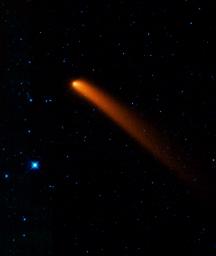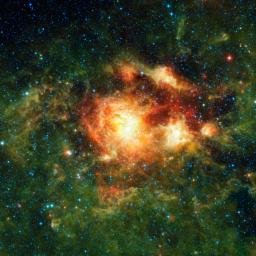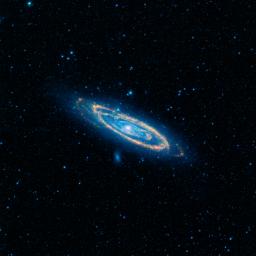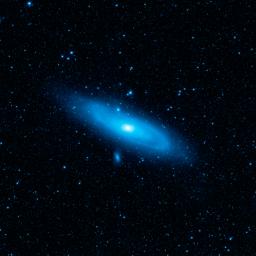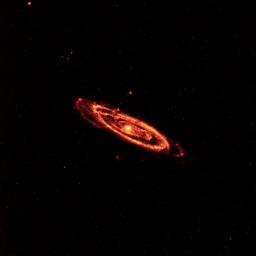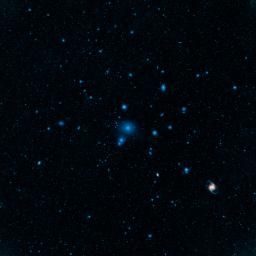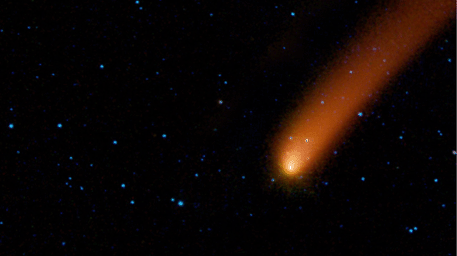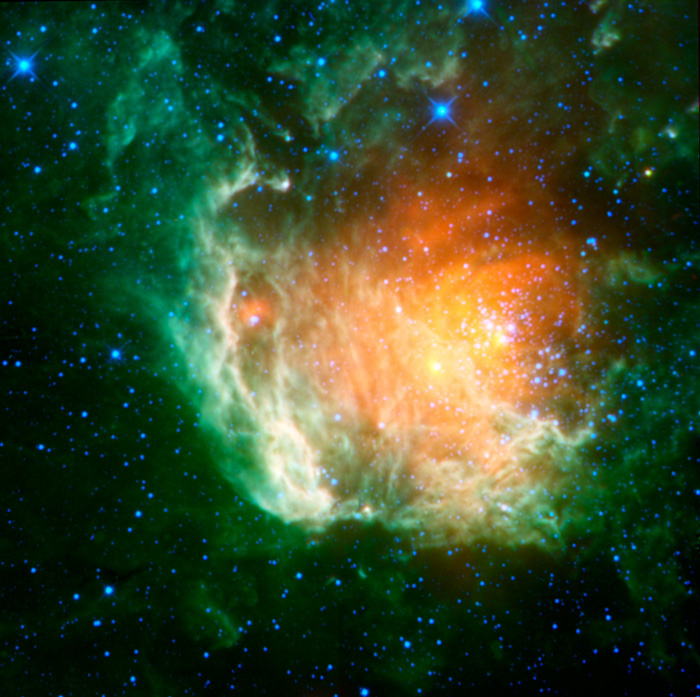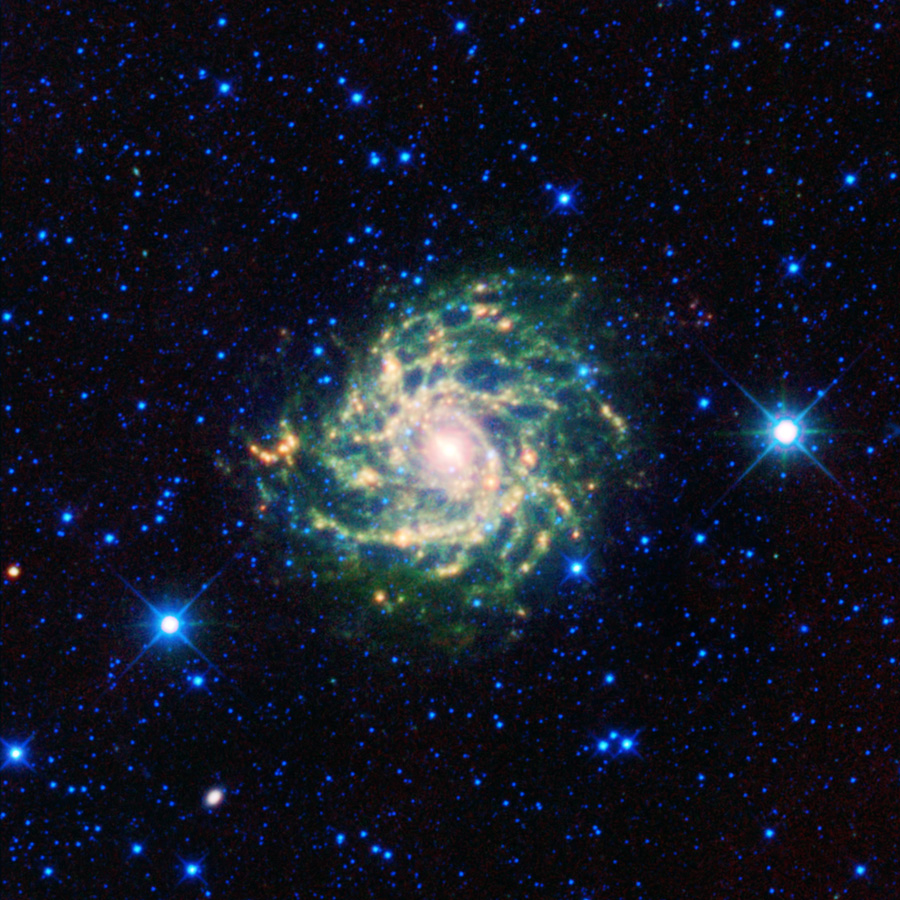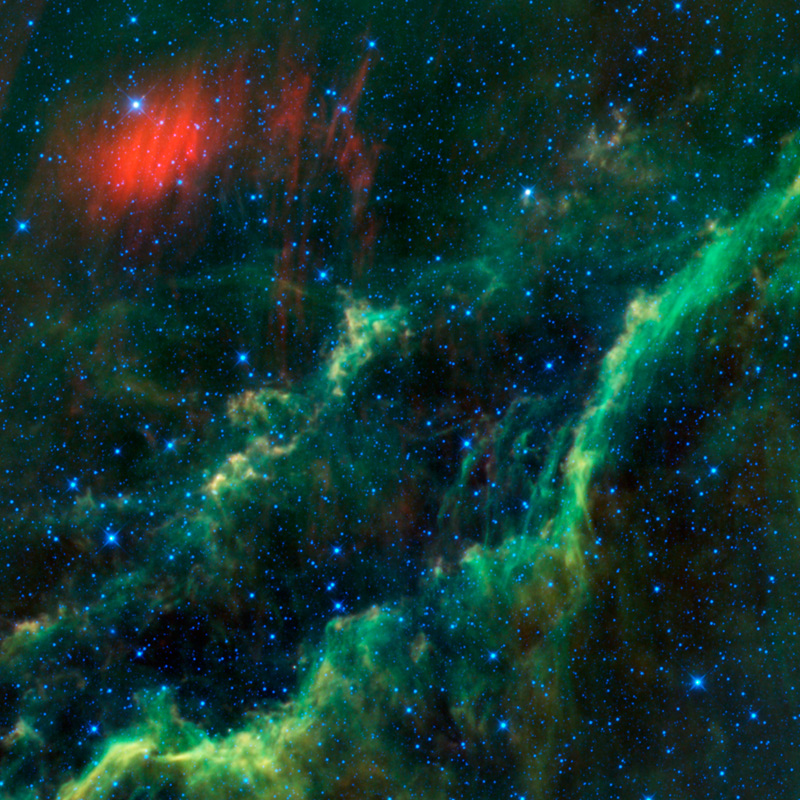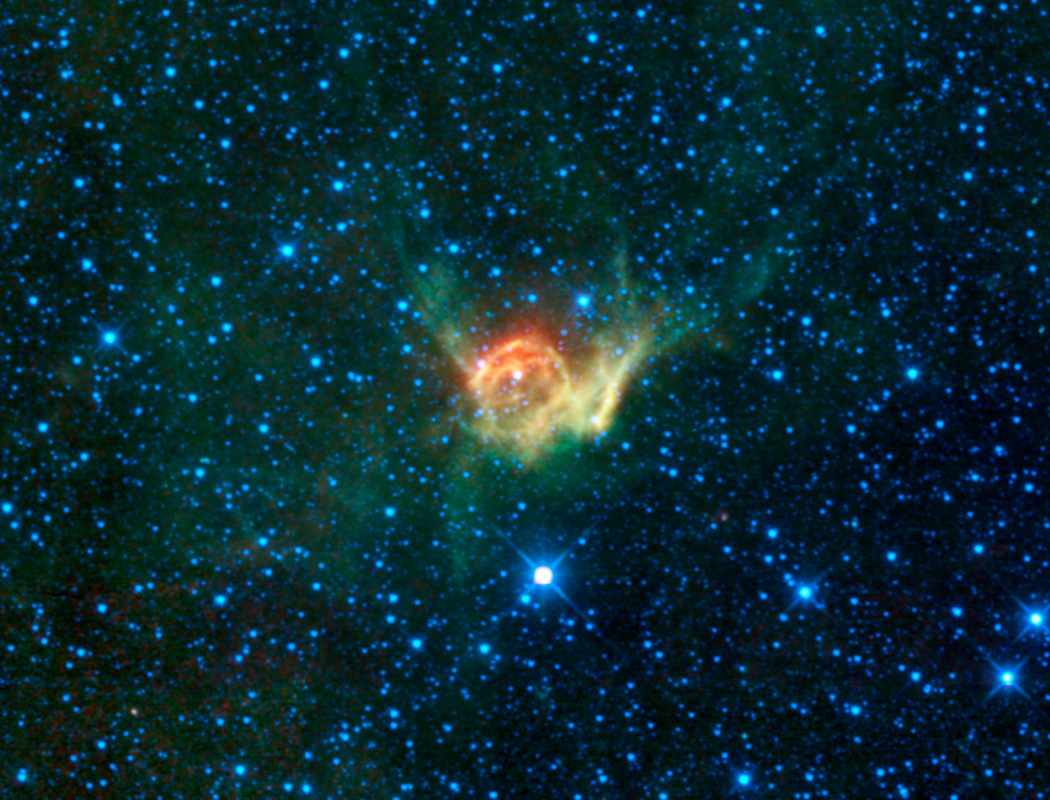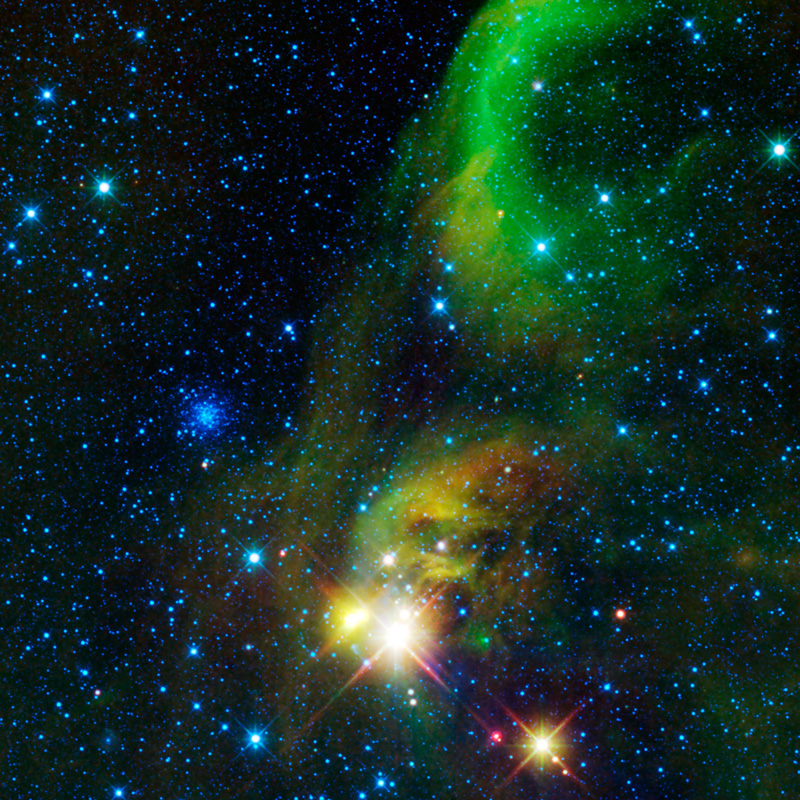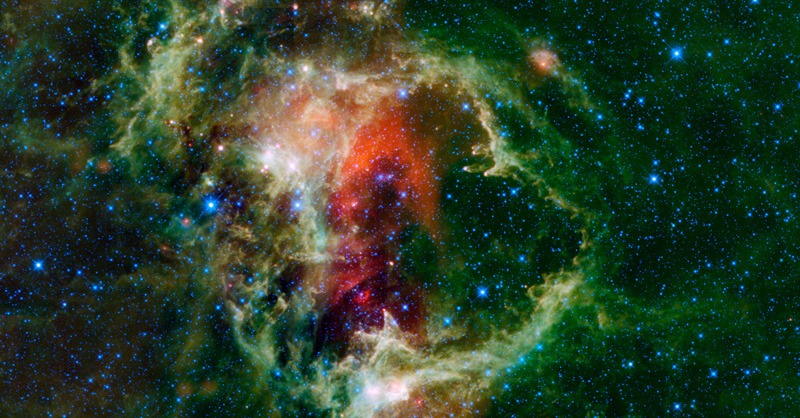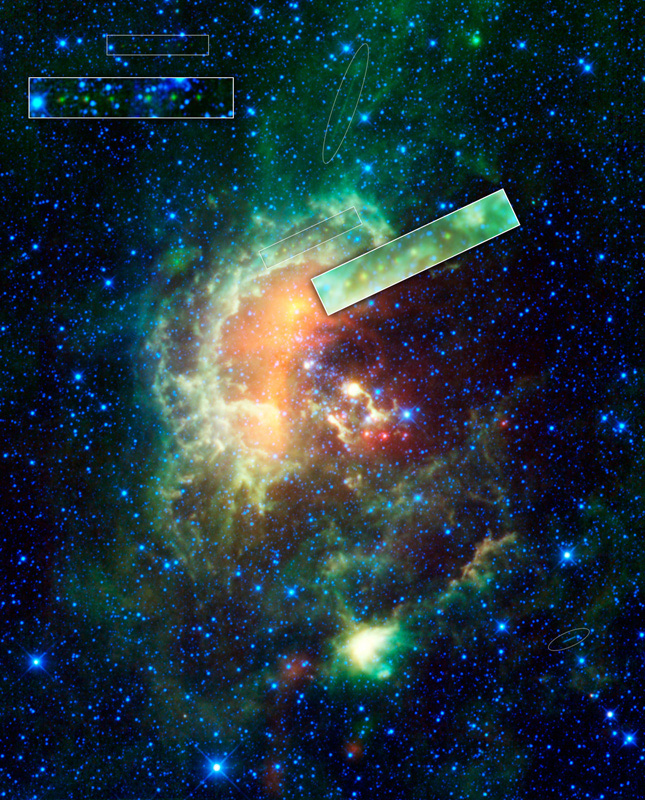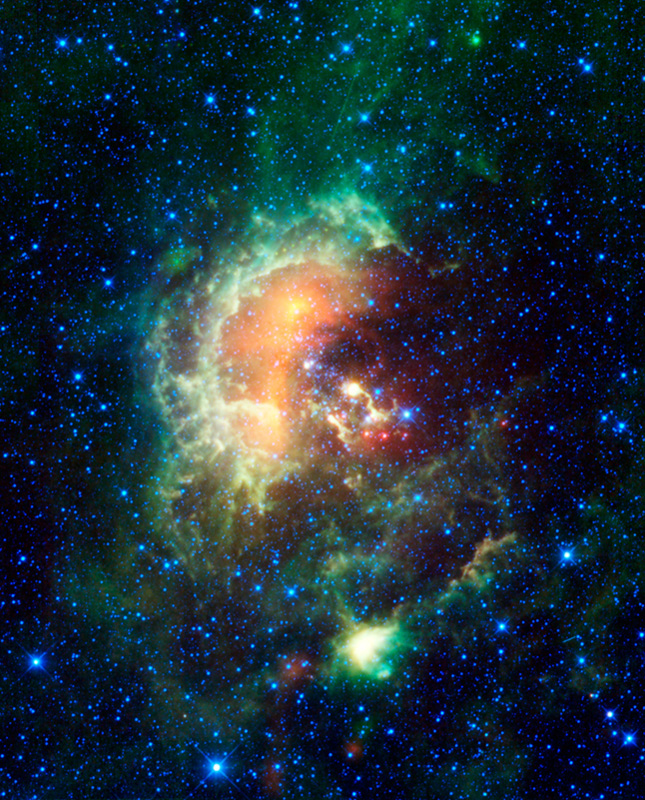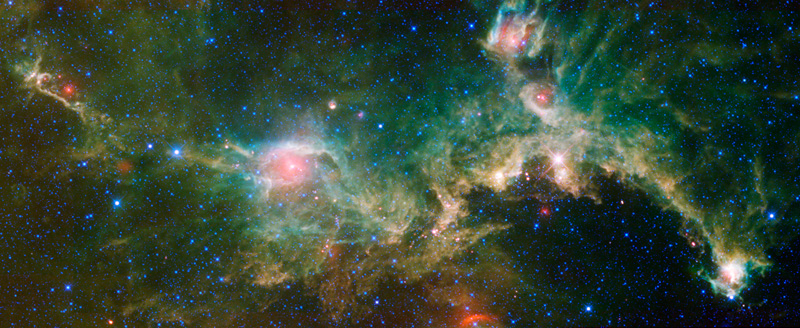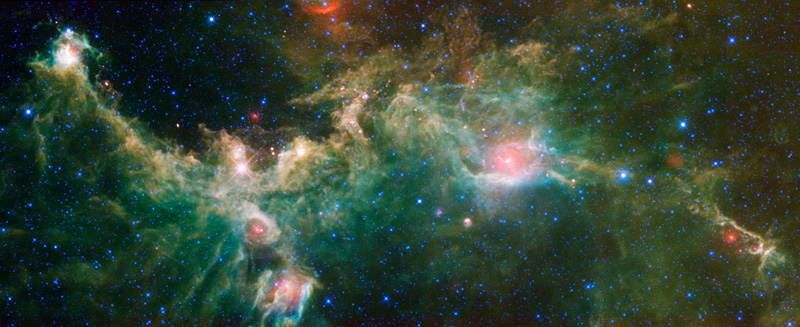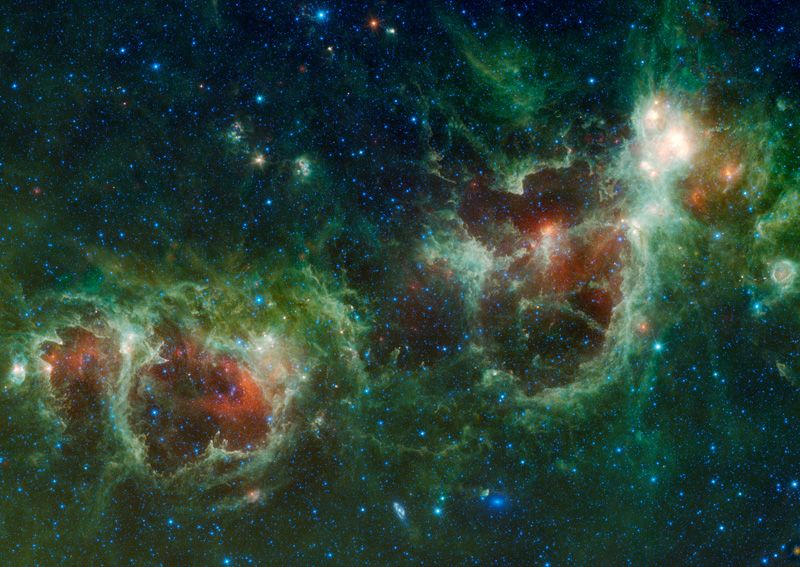See new, spectacular, or mysterious sky images.
-
bystander
- Apathetic Retiree
- Posts: 21590
- Joined: Mon Aug 28, 2006 2:06 pm
- Location: Oklahoma
Post
by bystander » Wed Feb 17, 2010 6:39 pm
-
bystander
- Apathetic Retiree
- Posts: 21590
- Joined: Mon Aug 28, 2006 2:06 pm
- Location: Oklahoma
Post
by bystander » Wed Feb 17, 2010 7:28 pm
-
RJN
- Baffled Boffin
- Posts: 1673
- Joined: Sat Jul 24, 2004 1:58 pm
- Location: Michigan Tech
Post
by RJN » Sat Mar 06, 2010 3:23 pm
Maffei 1 and 2 - 05 Mar 2010
Maffei 1 and 2
A mosaic of images from WISE in the constellation of Cassiopeia. This region contains a large star forming nebula within the Milky Way Galaxy, called IC 1805 (sometimes called the Heart Nebula), a portion of which is seen at the right of the image. IC 1805 is over 6 thousand light-years from Earth. Also visible in this image are two nearby galaxies, Maffei 1 and Maffei 2. In visible light these galaxies are hidden by dust in IC 1805 and were unknown until 1968 when Paolo Maffei found them using infrared observations. Both galaxies contain billions of stars and are located some 10 million light-years away (well outside our own Milky Way Galaxy). Maffei 1 is the bluish elliptical object in the center of the image. It is a Lenticular type galaxy, which has a disk-like structure and a central bulge but no spiral structure or appreciable dust content. Maffei 2 (to the upper left of Maffei 1) is a Spiral type galaxy that also has a disk shape, but with a bar-like central bulge and two prominent dusty spiral arms.
The image size is about 1.6 by 4.5 degrees (The full Moon is about 0.5 degrees across by comparison). Since this is an image of invisible infrared light, blue is mapped to the WISE 3.4 & 4.6 micron channels and is dominated by star light. Green represents the WISE 12 micron channel, and red is the 22 micron channel, which are dominated by infrared emission from warm interstellar dust.
Credit: NASA/JPL-Caltech/WISE Team
-
bystander
- Apathetic Retiree
- Posts: 21590
- Joined: Mon Aug 28, 2006 2:06 pm
- Location: Oklahoma
Post
by bystander » Mon Mar 08, 2010 6:33 am
WISE's weekly featured image
Planetary Society Blog - 2010 March 07
Every space mission has its own style of public outreach; you never know quite what you're going to get until it launches and is in the full swing of operations. So I'm pleased to point out that the Wide-field Infrared Survey Explorer mission (WISE) has started an "image of the week" feature on its
website. It's a survey mission, systematically capturing photo after photo of the heavens in a pre-ordained geometric pattern, so I can see the mission scientists checking each day's downlink to validate the data quality and periodically saying, "hey, this one is really pretty." Now they can flag those pretty ones and post them for the public's benefit. Here's the first such image. Do click to enlarge; it is HUGE and hugely detailed.
-
bystander
- Apathetic Retiree
- Posts: 21590
- Joined: Mon Aug 28, 2006 2:06 pm
- Location: Oklahoma
Post
by bystander » Tue Mar 16, 2010 2:40 pm
WISE: Wizard Nebula: NGC 7380 - 2010 March 12
Wizard Nebula: NGC 7380
This picture of the open star cluster NGC 7380 is a mosaic of images from the WISE mission spanning an area on the sky of about 5 times the size of the full Moon. NGC 7380 is located in the constellation Cepheus about 7,000 light-years from Earth within the Milky Way Galaxy. The star cluster is embedded in a nebula, sometimes called the Wizard Nebula, which spans some 110 light-years. The stars of NGC 7380 have emerged from this star forming region in the last 5 million years or so, making it a relatively young cluster.
NGC 7380 was discovered by Caroline Herschel in 1787. Her brother, William Herschel, discovered infrared light in 1800. All four infrared detectors aboard WISE were used to make this image. Color is representational: blue and cyan represent infrared light at wavelengths of 3.4 and 4.6 microns, which is primarily light from stars. Green and red represent light at 12 and 22 microns, which is primarily emission from warm dust.
Credit: NASA/JPL-Caltech/WISE Team
-
neufer
- Vacationer at Tralfamadore
- Posts: 18805
- Joined: Mon Jan 21, 2008 1:57 pm
- Location: Alexandria, Virginia
Post
by neufer » Tue Mar 16, 2010 4:48 pm
A BC D -EFGH I JKLMNOPQ R STUV W XY Z
Z YX W VUTS R QPONMLKJ I HGFE- D CB A
DRAZIW
WIZARD , n. [Origin unknown, probably from wise + -ard.]
One devoted to the black art; a magician; a conjurer; a sorcerer; an enchanter.

Art Neuendorffer
-
bystander
- Apathetic Retiree
- Posts: 21590
- Joined: Mon Aug 28, 2006 2:06 pm
- Location: Oklahoma
Post
by bystander » Tue Mar 16, 2010 6:51 pm
WISE: Cosmic Rose: Berkeley 59 and NGC 7822 - 2010 March 16
Cosmic Rose: Berkeley 59 and NGC 7822
A new infrared image from NASA's Wide-field Infrared Survey Explorer, or WISE, shows a cosmic rosebud blossoming with new stars. The stars, called the Berkeley 59 cluster, are the blue dots to the right of the image center. They are ripening out of the dust cloud, NGC 7822, from which they formed, and at just a few million years old, are young on stellar time scales.
The rosebud-like red glow surrounding the hot, young stars is warm dust heated by the stars. Green "leafy" nebulosity enfolds the cluster, showing the edges of the dense, dusty cloud. This green material is from heated polycyclic aromatic hydrocarbons, molecules that can be found on Earth in barbecue pits, exhaust pipes and other places where combustion has occurred.
Red sources within the green nebula indicate a second generation of stars forming at the surface of the natal cloud, possibly as a consequence of heating and compression from the younger stars. A supernova remnant associated with this region, called NGC 7822, indicates that a massive star has already exploded, blowing the cloud open in a "champagne flow" and leaving behind this floral remnant. Blue dots sprinkled throughout are foreground stars in our Milky Way galaxy.
Berkeley 59 and NGC 7822 are located in the constellation Cepheus at a distance of about 3,300 light-years from Earth.
Infrared light is color coded in this picture as follows: blue shows 3.4-micron light; cyan, 4.6-micron light; green, 12-micron light; and red, 22-micron light.
Credit: NASA/JPL-Caltech/WISE Team
-
owlice
- Guardian of the Codes
- Posts: 8406
- Joined: Wed Aug 04, 2004 4:18 pm
- Location: Washington, DC
Post
by owlice » Wed Mar 17, 2010 3:29 pm
Wow; that's really lovely.
A closed mouth gathers no foot.
-
bystander
- Apathetic Retiree
- Posts: 21590
- Joined: Mon Aug 28, 2006 2:06 pm
- Location: Oklahoma
Post
by bystander » Wed Apr 07, 2010 10:06 pm
WISE: IC 342 - The Hidden Galaxy - 07 Apr 2010
IC 342: Hiding Out Behind the Milky Way
A leggy cosmic creature comes out of hiding in this new infrared view from NASA's Wide-field Infrared Survey Explorer, or WISE. The spiral beauty, called IC 342 and sometimes the "hidden galaxy," is shrouded behind our own galaxy, the Milky Way. Stargazers and professional astronomers have a hard time seeing the galaxy through the Milky Way's bright band of stars, dust and gas. WISE's infrared vision cuts through this veil, offering a crisp view.
In a spiral galaxy like IC 342, dust and gas are concentrated in the arms. The denser pockets of gas trigger the formation of new stars, as represented here in green and yellow. The core, shown in red, is also bursting with young stars, which are heating up dust. Stars that appear blue reside within our Milky Way, between us and IC 342.
This galaxy has been of great interest to astronomers because it is relatively close. However, determining its distance from Earth has proven difficult due to the intervening Milky Way. Astronomer Edwin Hubble first thought the galaxy might belong to our own Local Group of galaxies, but current estimates now place it farther away, at about 6.6 to 11 million light-years.
This image was made from observations by all four infrared detectors aboard WISE. Blue and cyan represent infrared light at wavelengths of 3.4 and 4.6 microns, which is primarily light from stars. Green and red represent light at 12 and 22 microns, which is primarily emission from warm dust.
Credit: NASA/JPL-Caltech/UCLA/WISE Team
JPL: Hiding Out Behind the Milky Way
PIA13021: Hiding Out Behind the Milky Way
-
bystander
- Apathetic Retiree
- Posts: 21590
- Joined: Mon Aug 28, 2006 2:06 pm
- Location: Oklahoma
Post
by bystander » Tue May 11, 2010 6:34 pm
Menkhib and the California Nebula - 10 May 2010
Menkhib and the California Nebula
This infrared image from NASA's Wide-field Infrared Survey Explorer, or WISE, features one of the bright stars in the constellation Perseus, named Menkhib (at upper left near the red dust cloud), along with a large star-forming cloud NGC 1499, or the California nebula, seen running diagonally through the image.
Menkhib is one of the hottest stars visible in the night sky; its surface temperature is about 37,000 Kelvin (about 66,000 degrees Fahrenheit, or more than six times hotter than the sun). Because of its high temperature, it appears blue-white to the human eye (almost all stars appear bluish to WISE). It has about 40 times the mass of the sun and gives off 330,000 times the amount of light. Menkhib is a runaway star, and the fast stellar wind it blows is piling up in front of it to create a shock wave. This shock wave is heating up dust, which WISE sees as the red cloud in the upper left of the image.
Menkhib is part of an association of very hot stars that were born from the California nebula only a few million years ago. These stars are lighting up the nebula, as wekk as heating and ionizing it. In visible light, the ionized gas glows red, while in infrared light we see the heated dust (which appears in green and red in this image). The California nebula gets its name due to a resemblance to the shape of the U.S. State California (which you can just make out, outlined by the green dust, if you rotate the image by a little more than 90 degrees clockwise). The entire California nebula stretches across about 100 light-years, and we see about 80 percent of it in this view.
Menkhib and the California nebula are about 1,800 light-years away from Earth. This is within the same spur of the Orion spiral arm of the Milky Way galaxy where we are located.
All four infrared detectors aboard WISE were used to make this image. Color is representational: blue and cyan represent infrared light at wavelengths of 3.4 and 4.6 microns, which is dominated by light from stars. Green and red represent light at 12 and 22 microns, which is mostly light from warm dust.
Credit: NASA/JPL-Caltech/UCLA/WISE Team
-
bystander
- Apathetic Retiree
- Posts: 21590
- Joined: Mon Aug 28, 2006 2:06 pm
- Location: Oklahoma
Post
by bystander » Tue May 11, 2010 10:26 pm
NGC 2359: Thor's Helmet - 30 Apr 2010
NGC 2359: Thor's Helmet
This heroic image from WISE is of a special cloud of dust and gas in the constellation Canis Major catalogued as NGC 2359. The nebula is more commonly known as Thor's Helmet due to its remarkable resemblance to depictions of the headwear donned by the famed Norse god of thunder and lightning.
Powering Thor’s Helmet is HD 56925, a highly luminous "Wolf-Rayet" star (seen at the center of the helmet). These kinds of stars are massive; from 10 to 80 times the mass of our Sun. Such stars are often associated with bright nebulae, many of which appear to be spherical bubbles with the Wolf-Rayet star at the center. It is thought that the progenitors of these stars are either red supergiants or luminous blue variable stars, both of which slowly shed matter as they age. Once the star enters its Wolf-Rayet phase its strong, fast stellar wind sweeps up the surrounding debris left by the original star and even gathers up interstellar matter from its environment. It literally blows a bubble in space. These hot stars become 200,000 times more luminous than the Sun. They flood the nebula with ultraviolet light that ionizes much of the gaseous material leading to the bright emission in visible light. Interactions with a nearby large molecular cloud are thought to have contributed to the more complex shape and curved bow-shock structure of Thor's Helmet.
NGC 2359 was the first Wolf-Rayet nebula to be discovered. Between 1917 and 1919, Francis Pease studied the nebula at the Mt. Wilson observatory in southern California. He described the bright regions of the nebula as matching the descriptions of early observers such as Sir John Herschel (son of the discoverer of infrared light, William Herschel), who saw a bust rather than a helmet. The object was later found to show nitrogen emission by Edwin Hubble and listed in his 1922 paper, A general study of diffuse galactic nebulae. The object has also been of interest to members of the WISE science team during their careers having been studied by Martin Cohen and the WISE Principal Investigator Ned Wright, who co-authored an article in the March 1980 issue of Sky & Telescope, A bubble in space - The shell of NGC 2359.
Thor's Helmet is about 30 light-years across and its distance from Earth is estimated to be about 15,000 light-years. This image covers an area of sky about 2.5 times the size of the full Moon. All four infrared detectors aboard WISE were used to make this image. Color is representational: blue and cyan represent infrared light at wavelengths of 3.4 and 4.6 microns, which is dominated by light from stars. Green and red represent light at 12 and 22 microns, which is mostly light from warm dust.
Credit: NASA/JPL-Caltech/WISE Team
-
bystander
- Apathetic Retiree
- Posts: 21590
- Joined: Mon Aug 28, 2006 2:06 pm
- Location: Oklahoma
Post
by bystander » Tue May 11, 2010 10:32 pm
NGC 6723: Star Clusters Young and Old, Near and Far - 23 Apr 2010
NGC 6723: Star Clusters Young and Old, Near and Far
This colorful image from WISE (Wide-field Infrared Survey Explorer) is a view of an area of the sky over 12 times the size of the full Moon on the border of the constellations Sagittarius and Corona Australis. Two types of star clusters are visible in the image.
The wispy nebula running top to bottom of this image is a nearby star forming region. In visible light the dust within the nebula obscures and reflects the light of the stars within and behind it, giving rise to several catalogued nebula (NGC 6726, NGC 6727, NGC 6729, IC 4812). But here in infrared light we see the light of the dust itself as it is warmed by the light of the newborn stars in the cluster (green and red). We also see through the dust to peer at the stars nestled within (blue/cyan). This star cluster has been called the Coronet Cluster. It is located some 420 light-years from Earth, and stretches about 10 light-years across. The Coronet Cluster is a relatively loose cluster of only a few dozen stars, many of which are only a few million years old.
Just to the left of center is a very different kind of star cluster. NGC 6723 is a globular star cluster located some 29,000 light-years away from Earth, and spans about 65 light-years in size. Globular star clusters contain hundreds of thousands to millions of stars and orbit around the Galaxy in a spherical halo surrounding it. These are some of the oldest stars in the Universe, over 10 billion years old.
All four infrared detectors aboard WISE were used to make this image. Color is representational: blue and cyan represent infrared light at wavelengths of 3.4 and 4.6 microns, which is dominated by light from stars. Green and red represent light at 12 and 22 microns, which is mostly light from warm dust.
Credit: NASA/JPL-Caltech/WISE Team
-
bystander
- Apathetic Retiree
- Posts: 21590
- Joined: Mon Aug 28, 2006 2:06 pm
- Location: Oklahoma
Post
by bystander » Tue May 11, 2010 10:36 pm
IC 1795 - 16 Apr 2010
IC 1795
This image from WISE is a view within the constellation Cassiopeia of another portion of the vast star forming complex that makes up part of the Perseus spiral arm of the Milky Way Galaxy. Two of the previously released images from WISE are also a part of the same star formation complex of nebulae: The Soul Nebula and Maffei 1 and 2. A distinct star forming region is visible in the bottom right corner this image, called IC 1795. Most of this region appears dark and relatively devoid of stars in photographs taken in visible light. This is because of the obscuring dust, but that same dust glows brightly in the infrared images obtained by WISE. The cloud is located just over 6,000 light-years away from Earth. Stars forming in this image are all relatively young, on the order of millions of years. That is young in comparison to stars like the Sun, which is nearly 5 billion years old.
This image covers an area of sky larger than 12 full Moons. All four infrared detectors aboard WISE were used to make this image. Color is representational: blue and cyan represent infrared light at wavelengths of 3.4 and 4.6 microns, which is dominated by light from stars. Green and red represent light at 12 and 22 microns, which is mostly light from warm dust.
Credit: NASA/JPL-Caltech/WISE Team
-
bystander
- Apathetic Retiree
- Posts: 21590
- Joined: Mon Aug 28, 2006 2:06 pm
- Location: Oklahoma
Post
by bystander » Tue May 11, 2010 10:40 pm
IC 1848: Soul Nebula - 02 Apr 2010
IC 1848: Soul Nebula
This WISE mosaic is of the Soul Nebula (a.k.a. the Embryo Nebula, IC 1848, or W5). It is an open cluster of stars surrounded by a cloud of dust and gas over 150 light-years across and located about 6,500 light-years from Earth in the constellation Cassiopeia, near the Heart Nebula (partially seen in the WISE image of Maffei 1 & 2).
The cluster of stars, IC 1848, formed about a million years ago from the material of the nebula. Winds and ultraviolet light from these young stars are excavating a cavity in the cloud. Parts of the cloud that are more dense than their surroundings are being eroded more slowly and form giant towers, or pillars of dust and gas, which all point toward the central star cluster. It’s reminiscent of the landscape of Badlands National Park in South Dakota. Material at the interior edges of the cavity is also being compressed by the winds and radiation from the star cluster. This triggers new star formation in those areas. The pillars inside the Soul Nebula are each about 10 light-years tall and have stars forming at their tips.
All four infrared detectors aboard WISE were used to make this image. Color is representational: blue and cyan represent infrared light at wavelengths of 3.4 and 4.6 microns, which is primarily light from stars. Green and red represent light at 12 and 22 microns, which is primarily emission from warm dust.
Credit: NASA/JPL-Caltech/WISE Team
-
owlice
- Guardian of the Codes
- Posts: 8406
- Joined: Wed Aug 04, 2004 4:18 pm
- Location: Washington, DC
Post
by owlice » Tue May 11, 2010 11:02 pm
Oh, c'mon! I'd name this the Emerald Snake or Snakehead Nebula if it were up to me, and he's getting ready to bite something! Not much body off to the right there, but that head looks as though it means business!
A closed mouth gathers no foot.
-
bystander
- Apathetic Retiree
- Posts: 21590
- Joined: Mon Aug 28, 2006 2:06 pm
- Location: Oklahoma
Post
by bystander » Thu May 13, 2010 5:24 pm
Tadpole Nebula with Asteroid - 13 May 2010
Asteroid Caught Marching Across Tadpole Nebula
A new infrared image from NASA's Wide-field Infrared Survey Explorer, or WISE, showcases the Tadpole nebula, a star-forming hub in the Auriga constellation about 12,000 light-years from Earth. As WISE scanned the sky, capturing this mosaic of stitched-together frames, it happened to catch an asteroid in our solar system passing by. The asteroid, called 1719 Jens, left tracks across the image, seen as a line of yellow-green dots in the boxes near center (Figure 1). A second asteroid was also observed cruising by, as highlighted in the boxes near the upper left (the larger boxes are blown-up versions of the smaller ones).
But that's not all that WISE caught in this busy image -- two satellites orbiting above WISE (highlighted in the ovals) streak through the image, appearing as faint green trails. The apparent motion of asteroids is slower than satellites because asteroids are much more distant, and thus appear as dots that move from one WISE frame to the next, rather than streaks in a single frame.
This Tadpole region is chock full of stars as young as only a million years old -- infants in stellar terms -- and masses over 10 times that of our sun. It is called the Tadpole nebula because the masses of hot, young stars are blasting out ultraviolet radiation that has etched the gas into two tadpole-shaped pillars, called Sim 129 and Sim 130. These "tadpoles" appear as the yellow squiggles near the center of the frame. The knotted regions at their heads are likely to contain new young stars. WISE's infrared vision is helping to ferret out hidden stars such as these.
The 1719 Jens asteroid, discovered in 1950, orbits in the main asteroid belt between Mars and Jupiter. The space rock, which has a diameter of 19 kilometers (12 miles), rotates every 5.9 hours and orbits the sun every 4.3 years.
Twenty-five frames of the region, taken at all four of the wavelengths detected by WISE, were combined into this one image. The space telescope caught 1719 Jens in 11 successive frames. Infrared light of 3.4 microns is color-coded blue: 4.6-micron light is cyan; 12-micron-light is green; and 22-micron light is red.
Credit: NASA/JPL-Caltech/WISE Team
-
bystander
- Apathetic Retiree
- Posts: 21590
- Joined: Mon Aug 28, 2006 2:06 pm
- Location: Oklahoma
Post
by bystander » Fri May 21, 2010 3:00 am
Seagull Nebula - Running with the Big Dog - 20 May 2010
Seagull Nebula - Running with the Big Dog
The Seagull nebula, seen in this infrared mosaic from NASA’s Wide-field Infrared Survey Explorer, or WISE, draws its common name from its resemblance to a gull in flight. But it depends on your point of view. When the image is rotated 180 degrees it bears a passing resemblance to a galloping lizard – or perhaps a dragon or a dinosaur. The image spans an area about seven times as wide as the full Moon, and three times as high (3.55 by 1.37 degrees), straddling the border between the constellations Monoceros and Canis Major (the Big Dog). So you might say this lizard is running with the Big Dog, while the gull is flying from it.
Astronomers catalog the nebula as IC 2177. This cosmic cloud is one of many sites of star formation within the Milky Way Galaxy. It is located 3,800 light-years away from Earth, inside the Orion spur -- the same partial spiral arm of the Milky Way where our Solar System is located. The nebula is nearly 240 light-years across.
Astronomers list the region near the seagull’s eye (or lizard’s hip) as NGC 2327, which contains a cluster of stars born about 1.5 million years ago. The eye is the brightest and hottest of the newborn stars in the entire nebula, and heats up the dust so that it glows in infrared light.
All four infrared detectors aboard WISE were used to make this image. Color is representational: blue and cyan represent infrared light at wavelengths of 3.4 and 4.6 microns, which is dominated by light from stars. Green and red represent light at 12 and 22 microns, which is mostly light from warm dust.
Credit: NASA/JPL-Caltech/WISE Team
-
owlice
- Guardian of the Codes
- Posts: 8406
- Joined: Wed Aug 04, 2004 4:18 pm
- Location: Washington, DC
Post
by owlice » Fri May 21, 2010 3:04 am
Oh, that's very nice; thanks!
A closed mouth gathers no foot.
-
BMAONE23
- Commentator Model 1.23
- Posts: 4076
- Joined: Wed Feb 23, 2005 6:55 pm
- Location: California
Post
by BMAONE23 » Fri May 21, 2010 4:42 pm
Reminds me of a Klingon Battle Cruiser (bird of prey)
-
Hofi
- Ensign
- Posts: 78
- Joined: Wed May 20, 2009 5:49 am
- Location: Austria
-
Contact:
Post
by Hofi » Sat May 22, 2010 3:52 pm
Great images! Really nice!
-
bystander
- Apathetic Retiree
- Posts: 21590
- Joined: Mon Aug 28, 2006 2:06 pm
- Location: Oklahoma
Post
by bystander » Mon May 24, 2010 10:26 pm
Heart and Soul Nebulae - 24 May 2010
Heart and Soul Nebulae
The Heart and Soul nebulae are seen in this infrared mosaic from NASA’s Wide-field Infrared Survey Explorer, or WISE. The image covers an area of the sky over ten times as wide as the full moon, and eight times as high (5.5 x 3.9 degrees), in the constellation Cassiopeia.
Located about 6,000 light-years from Earth, the Heart and Soul nebulae form a vast star-forming complex that makes up part of the Perseus spiral arm of our Milky Way Galaxy. The nebula to the right is the Heart, designated IC 1805 and named after its resemblance to a human heart. To the left is the Soul nebula, also known as the Embryo nebula, IC 1848, or W5. The Perseus arm lies further from the center of the Milky Way than the arm that contains our Sun. The Heart and Soul nebulae stretch out nearly 580 light-years across, covering a small portion of the diameter of the Milky Way, which is roughly 100,000 light-years across.
The two nebulae are both massive star-making factories, marked by giant bubbles that were blown into surrounding dust by radiation and winds from the stars. WISE's infrared vision allows it to see into the cooler and dustier crevices of clouds like these, where gas and dust are just beginning to collect into new stars. These stars are less than a few million of years old -- youngsters in comparison to stars like the sun, which is nearly 5 billion years old.
Also visible near the bottom of this image are two galaxies, Maffei 1 and Maffei 2. Both galaxies contain billions of stars and, at about 10 million light-years away, are well outside our Milky Way yet relatively close compared to most galaxies. Maffei 1 is the bluish elliptical object and Maffei 2 is the spiral galaxy.
All four infrared detectors aboard WISE were used to make this image. Color is representational: blue and cyan represent infrared light at wavelengths of 3.4 and 4.6 microns, which is dominated by light from stars. Green and red represent light at 12 and 22 microns, which is mostly light from warm dust.
Image Credit: NASA/JPL-Caltech/WISE Team
WISE Telescope has Heart and Soul
NASA JPL WISE Mission News 2010-174 - 24 May 2010
NASA's Wide-field Infrared Survey Explorer, or WISE, has captured a huge mosaic of two bubbling clouds in space, known as the Heart and Soul nebulae. The space telescope, which has completed about three-fourths of its infrared survey of the entire sky, has already captured nearly one million frames like the ones making up this newly released mosaic.
"This new image demonstrates the power of WISE to capture vast regions," said Ned Wright, the mission's principal investigator at UCLA, who presented the new picture today at the American Astronomical Society meeting in Miami. "We're looking north, south, east and west to map the whole sky."
The Heart nebula is named after its resemblance to a human heart; the nearby Soul nebula happens to resemble a heart too, but only the symbolic kind with two lobes. The nebulae, which lie about 6,000 light-years away in the constellation Cassiopeia, are both massive star-making factories, marked by giant bubbles blown into surrounding dust by radiation and winds from the stars. The infrared vision of WISE allows it to see into the cooler and dustier crevices of clouds like these, where gas and dust are just beginning to collect into new stars.
The new image was captured as WISE circled over Earth's poles, scanning strips of the sky. It is stitched together from 1,147 frames, taken with a total exposure time of three-and-a-half hours.
-
owlice
- Guardian of the Codes
- Posts: 8406
- Joined: Wed Aug 04, 2004 4:18 pm
- Location: Washington, DC
Post
by owlice » Mon May 24, 2010 10:31 pm
A closed mouth gathers no foot.
-
bystander
- Apathetic Retiree
- Posts: 21590
- Joined: Mon Aug 28, 2006 2:06 pm
- Location: Oklahoma
Post
by bystander » Mon May 24, 2010 10:47 pm
-
owlice
- Guardian of the Codes
- Posts: 8406
- Joined: Wed Aug 04, 2004 4:18 pm
- Location: Washington, DC
Post
by owlice » Tue May 25, 2010 12:50 am
Oh, that was supposed to be additional, not discouraging! You provide context and information, which is always appreciated!
You know what I see now when I look at the Soul Nebula? A snake getting ready to bite a fetus...



A closed mouth gathers no foot.
